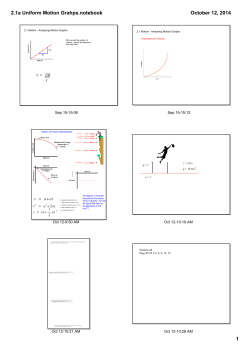
CP Physics Basic Mechanics Test—ANSWER KEY
CP Physics Basic Mechanics Test—ANSWER KEY True/False Indicate whether the statement is true or false. __T__ 1. In science, an educated guess about the answer to a scientific question is called a hypothesis. __T__ 2. The synthesis of a large collection of information that encompasses well-tested and verified hypotheses about certain aspects of the natural world is know as a scientific theory. __T__ 3. The rate at which velocity changes with time is called acceleration. __F__ 4. When a car rounds a corner at a constant speed, its acceleration is zero. __F__ 5. As a ball falls freely, the distance it falls each second is the same. __F__ 6. The amount of matter in an object is called its weight. __T__ 7. Inertia is the reluctance any material object has to change in its state of motion. __T__ 8. The combination of all the forces that act on an object is called the net force. __F__ 9. Objects move only when a force is exerted. __F__ 10. The acceleration of an object is inversely proportional to the net force acting on it. Multiple Choice Identify the choice that best completes the statement or answers the question. ____ 1. A scientific fact is a. an educated guess that has yet to be proven by experiment. b. a synthesis of a collection of data that includes well-tested guesses. c. close agreement by competent observers of observations of the same phenomena. d. a guess that has been tested over and over again and always found to be true. ____ 2. Which of these is a scientific hypothesis? a. Atoms are the smallest particles of matter that exist. c. Albert Einstein is the greatest physicist of the 20th Century. b. The universe is surrounded by a second universe that cannot be seen. ____ 3. Speed is a. a measure of how fast something is moving. b. the distance covered per unit time. c. always measured in terms of distance divided by a unit of time. d. all of the above. ____ 4. When you look at the speedometer in a moving car, you can see the car’s a. instantaneous speed. c. instantaeous acceleration. b. average speed d. average acceleration. ____ 5. Acceleration is defined as the change in a. position divided by the time interval. c. time it takes to move from one speed to another speed. b. velocity divided by the time interval. d. time it takes to move from one place to another place. ____ ____ 6. The Law of Inertia applies to a. moving objects. b. objects at rest. c. both moving and non-moving objects. 7. After a cannonball is fired into frictionless space, the amount of force needed to keep it going equals a. twice the force with which it was fired. c. one half the force with which it was fired. b. the same amount of force with which it d. zero, since no force is necessary to was fired. keep it moving. ____ 8. Which has more mass, a kilogram of feathers or a kilogram of iron? a. The feathers. c. Both masses are equal. b. The iron. ____ 9. A 10 N force and a 30 N force act on an object in opposite directions. What is the net force on the object? a. 40 N b. 30 N c. 20 N d. 10 N ____ 10. If a force acting on a cart doubles, what happens to the cart’s acceleration? a. It quadruples. c. It halves. b. It doubles. d. It quarters. ____ 11. A tennis ball and a solid steel ball the same size are dropped at the same time. Which ball has the greater force acting on it? a. The tennis ball. c. They both have the same force acting on them. b. The steel ball. ____ 12. A tennis ball and a solid steel ball the same size are dropped at the same time. In the absence of air resistance, which ball has the greater acceleration? a. The tennis ball. c. They both have the same acceleration. b. The steel ball. Problem (answer at least 4 of 5)--SHOW ALL FORMULAE, CALCULATIONS, AND UNITS OR YOU WILL NOT RECEIVE FULL CREDIT. 1. What is the average speed of a cheetah that runs 70 m in 2.5 seconds? 28 m/s. 2. An apple falls from a tree and one-half second later hits the ground. How fast is it falling when it hits the ground? 5.0 m/s. 3. Nellie weighs 300N. As she hangs on the rings, there is (perhaps) a varying level of tension on the ropes. Based on the three scenarios below, write the value of tension on each rope. Explain your values. 4. A firefighter who weighs 300 N slides down a fire pole at constant velocity. What is the force of friction on the firefighter? Defend your answer with a diagram and a calculation. Due to mechanical equilibrium, the upward force due to friction is exactly the same magnitude as the downward force of gravity. It is, therefore, 300N up. 5. You push with 30 N on a 3 kg block, and there are no opposing forces. What is the block’s acceleration? Essay (answer at least 3 of 4)--BE COMPLETE AND DETAILED IN YOUR RESPONSES. 1. Write a short paragraph explaining what acceleration is, and why a car is accelerating as it rounds a corner, even at a constant speed. Acceleration is the rate of change of velocity. Since velocity encompasses both speed and direction, a change in either is acceleration. 2. If you are playing catch with a friend in the aisle of a fast-moving airplane that travels at a constant velocity, in which (if any) direction does the ball gain more speed due to the plane’s motion? Explain your answer. The speed of the ball is relative to the frame of reference of the throwers who are IN the frame of reference of the plane. The speed of the ball relative to the throwers has nothing to do with its speed relative to the plane’s frame of reference (the Earth). The inertia on the throwers, the ball, and the plane means that they will continue moving in the same direction, and any internal motion in the plane is relative TO the plane alone. 3. Construct vectors A and B for the cases below. First, draw a vector W representing the weight of the object. Second, draw the support force vector. Third, determine the magnitude and direction of vectors A and B. 4. How does the added tension of a 1 kg bird on a horizontally stretched wire compare to the bird’s weight? If the angle to the horizontal is more than 30º, the tension in the wire is greater than the bird’s weight. The smaller the angle, the greater the tension.
© Copyright 2025





















